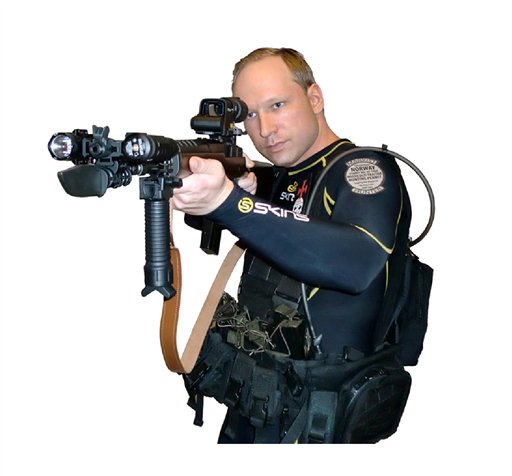A judge denied Anders Behring Breivik the public stage he wanted to air his anti-Muslim rants and call for revolution on Monday, ruling that the first hearing for the man who has confessed to Norway’s twin terror attacks be held behind closed doors.
Breivik had prepared a speech for his day in court even before launching the attacks that left 93 people dead and Norwegians reeling at the devastation. He had requested an open hearing in which he would wear a uniform, making clear in an Internet manifesto that he planned to turn his court appearance into theater.
He staged the bombing and youth camp rampage as “marketing” for his manifesto calling for a revolution that would rid Europe of Muslims, he said.
Reporters and locals thronged the courthouse on Monday ahead of the hearing for their first glimpse of Breivik since the assault. When one car drove through the crowd, people hit its windows and one person shouted an expletive, believing Breivik was inside.
The hearing ended after about 35 minutes. A guard at the courthouse told reporters, “everyone has left.”
Peaceful, liberal Norway has been stunned by the bombing in downtown Oslo and the shooting massacre at a youth camp outside the capital, which the suspect said were intended to start a revolution to inspire Norwegians to retake their country from Muslims and other immigrants. He blames liberals for championing multiculturalism over Norway’s “indigenous” culture.
“Based on information in the case the court finds that today’s detention hearing should be held behind closed doors,” Judge Kim Heger said in a statement. “It is clear that there is concrete information that a public hearing with the suspect present could quickly lead to an extraordinary and very difficult situation in terms of the investigation and security.”
The court acknowledged that there was a need for transparency in the case and that it normally would consider arguments from the press when making decisions to close hearings but said that wasn’t possible “for practical reasons.”
It’s unusual that the hearing was closed even before it began. Normally, a judge would make such a decision in open court.
Typically, the accused is brought to court every four weeks while prosecutors prepare their case, so a judge can approve his continued detention. In cases of serious crimes or where the defendant has admitted to the charges, longer periods of detention are not unusual.
Prime Minister Jens Stoltenberg led the mourning nation in a minute of silence on Monday, standing on the steps of an Oslo university next to a flame. The king and queen stood by as well, and neighboring countries Denmark and Sweden also joined in the remembrance.
Signs of normality began to return to Oslo on Monday. A wide police cordon around the bomb site was lifted on the first workday since the attacks, leaving just a narrower zone closed off. Most shops were open and trams were rumbling through the city’s streets.
But the flag on the courthouse where Breivik will appear remained at half staff, and the world’s media was buzzing around the building.
The search for more victims continues and police have not released the names of the dead. But Norway’s royal court said Monday that those killed at the island retreat included Crown Princess Mette-Marit’s stepbrother, an off-duty police officer, who was working there as a security guard.
Court spokeswoman Marianne Hagen told The Associated Press that his name was Trond Berntsen, the son of Mette-Marit’s stepfather, who died in 2008.
Meanwhile, French police were searching the suspect’s father’s home Monday. About a dozen officers surrounded the house in Couranel in southern France, entering and leaving at irregular intervals. The house is cordoned off, and reporters do not have access.
The regional gendarme service confirmed the house was that of Anders Behring Breivik’s father but would not comment on the search operation. News reports have said Breivik’s father, Jens Breivik, has not been in touch with his son in many years.
The attacks rattled Norway, a small and wealthy country unused to political violence, and known internationally as a peace mediator, prominent foreign aid donor and as home of the Nobel Peace Prize. Survivors of the camp shooting on the Utoya island described how a gunman dressed in a police uniform urged people to come closer and then opened fire, sending panicked youth fleeing into the water.
Police say 86 people were killed. About 90 minutes earlier, a car bomb exploded in the government district in central Oslo, killing seven.
More than 90 people were wounded, and others remain missing at both crime scenes.
Breivik laid out his extreme nationalist philosophy as well as his attack methods in a 1,500-page manifesto. It also describes how he bought armor, guns, tons of fertilizer and other bomb components, stashed caches of weapons and wiping his computer hard drive — all while evading police suspicion and being nice to his neighbors.
Dr. Colin Poole, head of surgery at Ringriket Hospital in Honefoss northwest of Oslo, told The Associated Press that the gunman used special bullets designed to disintegrate inside the body and cause maximum internal damage. Poole said surgeons treating 16 gunshot victims have recovered no full bullets.
“These bullets more or less exploded inside the body,” Poole said. “It’s caused us all kinds of extra problems in dealing with the wounds they cause, with very strange trajectories.”
Ballistics experts say “dum-dum”-style bullets also are lighter in weight and can be fired with greater accuracy over varying distances.
——
Associated Press writers Angela Charlton in Paris, Sarah DiLorenzo in Stockholm and Shawn Pogatchnik in Oslo, Norway, contributed to this report.

